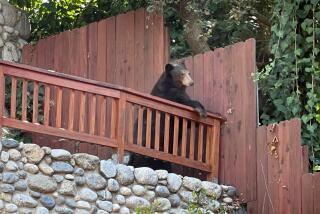Dear Street Smart:Much has been said about...
Dear Street Smart:
Much has been said about the different freeway shutdowns, but I have never heard anything about the transition from the northbound Golden State Freeway to the eastbound Foothill Freeway in Sylmar.
Since the quake, we have had to use Roxford Boulevard to Glenoaks Boulevard in order to get into Sylmar. Do you know when this transition might open?
Kathleen Scrase Sylmar
Dear Reader:
The transition road of which you write was partially opened at the end of last month, with traffic diverted into the car-pool lanes. But it is still not back up to snuff. Russ Snyder of Caltrans tells us that the entire $3.2-million reconstruction project should be finished by the end of August and all lanes will again be open.
*
Dear Street Smart:
A couple of months ago, I saw a television news feature about speed humps that were installed to slow traffic in residential neighborhoods.
Where I live on Covello Street is home to numerous small children and is generally a peaceful and well-maintained residential neighborhood.
The problem is that this is one of the few streets that leads out of the development and provides easy neighborhood access. Cars often travel this quarter-mile, smooth street at full throttle, often in excess of 50 or 60 m.p.h.
How do I find out more about speed humps? What steps must be taken to have them installed?
David Thornton Van Nuys
Dear Reader:
Your question is well-timed: Just a few weeks ago, the city issued guidelines on how to petition for speed humps in residential neighborhoods.
Residents interested in applying for speed humps must first contact the city Department of Transportation to see if their street qualifies as a “local street” on the community plan. Only such local streets are eligible for speed humps, and are different from major boulevards such as Victory and Burbank and the semi-major “collector roads” in between them.
If your street is classified as a local street, it still must meet other criteria dealing with traffic volume, the posted speed limit, the street length and the impact speed humps would have by diverting traffic onto other nearby thoroughfares.
The city will draw up a priority list based on a neighborhood’s accident rate, common speeds of cars and other information. But because it has become such a popular request, don’t expect that you’ll get speed humps in your neighborhood right away even if your request--and an official petition with a signature requirement--is approved.
In fact, you and your neighbors may even have to pay for the speed humps yourselves; the city will only fund a portion of them. Speed humps can cost $6,000 to install three on a street.
The typical speed hump--different from the higher, more steeply angled and more jarring speed bumps in parking lots--is 12 feet long and 2 to 3 inches high. Tests show the humps reduce average traffic speed by 7 m.p.h.
To initiate your request, write the city of Los Angeles, Department of Transportation, Speed Hump Program, 200 N. Spring St., Room 1200, Los Angeles, Calif. 90012.
Street Smart appears Mondays in The Times Valley Edition.
More to Read
Sign up for Essential California
The most important California stories and recommendations in your inbox every morning.
You may occasionally receive promotional content from the Los Angeles Times.










